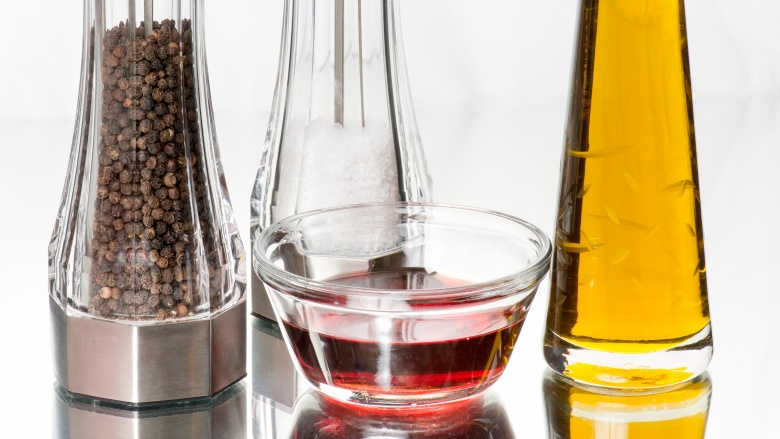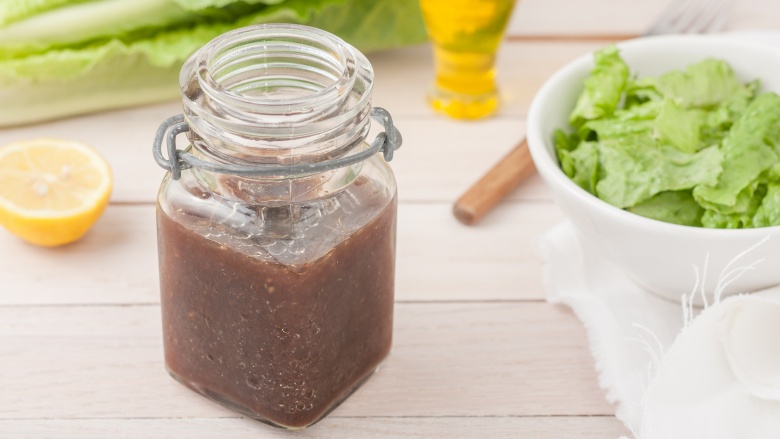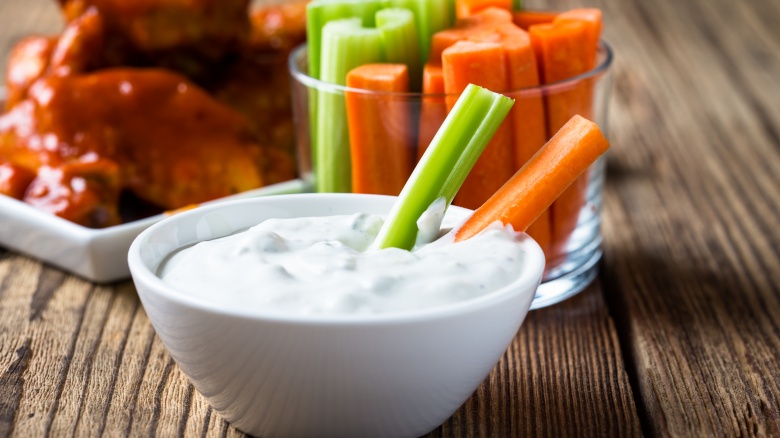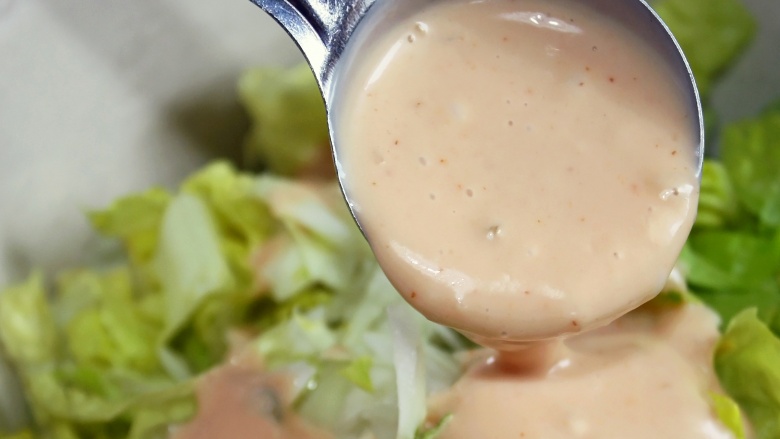What's Really In Your Salad Dressing
Salads can be so, so deceiving. You might think you're doing right by ordering one, eating healthier and getting all your veggies for the day. But take a look at what's in some of the most popular salad dressings and you might be surprised to find how bad they really are. We have your back, though, and by the time you're done here you're not just going to know what to look out for, but you're going to have some better alternatives, too.
Ranch
Ever wonder why it's actually called "ranch" dressing? That's because it was quite literally invented on a ranch, Hidden Valley Ranch, to be precise. It was a real place, and it was the California home of an Alaskan plumber named Steve Henson. Henson was famous for cooking for his guests, and among his specialties was a salad dressing made from a buttermilk base. The dressing was perfected in California, and the original recipe contained buttermilk, mayonnaise, and a handful of herbs and spices. That recipe has changed quite a bit with the commercialization of Hidden Valley, and most of it has to do with shelf life. Today, the main ingredients are vegetable oil, water, egg yolk, and sugar, with a whole bunch of unpronounceable ingredients.
Ranch dressing is (or should be) something of a guilty pleasure, and while it's one of the most popular dressings out there, it's also single-handedly capable of ruining any healthy aspirations that a salad might once have. A single serving size of 2 tablespoons (and who uses just 2 tablespoons?) contains a whopping 14 grams of fat and 140 calories. What? Why, in the name of all that's good and holy, does something so amazing have to be so horrible for you?
Fortunately, there are a literal ton of recipes out there that will give you a fix for your ranch dressing craving without all the heavy saturated fats that are in the store-bought stuff. Try this recipe from Kim's Cravings for a yogurt-based ranch dressing or, if you want to get back to basics with a buttermilk base, try this one from Chowhound.
Italian
Something of a misnomer, Italian dressing won't be served on any menu in Italy. It's strictly an American invention. Like most dressings, there's a lot of variety when it comes to actual ingredients, but the basic Italian dressing includes an oil base with white wine vinegar, parsley, cloves, basil, dried red pepper, oregano, and lemon juice. For creamy Italian, that's made with a dash of mayonnaise.
It's a slightly healthier dressing than ranch, and if you're talking about a brand like Wish-Bone, the standard 2 tablespoon serving size will add about 80 calories and 7 grams of fat onto your salad. Like all other store-bought dressings, the Italian also includes a whole host of ingredients to help keep it fresh on the shelf, like salt, xanthan gum, and calcium disodium EDTA. Opt for the creamy Italian, and you're adding in some buttermilk powder, whey, and a host of other additives like propylene glycol alginate, sorbic acid, and sodium benzoate. You're also raising your calories to 110 per serving and fat to 10 grams, but there are plenty of healthier recipes online if you're looking for all of the taste with none of the additives. Try this one from the Brown Eyed Baker, a recipe that uses vinegar and Romano cheese for the familiar kick that keeps you piling this one on your salads.
French
Depending on where in the world you are, this one will vary quite a bit. If you happen to be in Europe and order a salad with French dressing, don't expect it to be orange. This type of French dressing is a vinaigrette, and the BBC's recipe for it calls for white wine vinegar, Dijon mustard, garlic clove, and groundnut oil. That's not what Americans mean when they say "French dressing," and it can be a bit of a surprise the first time you ask for it.
In the U.S., it's that reddish-orange goodness that stands out from all the rest of the dressings. Just when you think you might never put ketchup on your salad ... well, that's exactly what you're doing. It seems like French dressing in the U.S. was originally much like the European version until a 1902 cookbook called "Mrs. Rorer's New Cook Book" suggested taking a boring old vinaigrette and adding some new flavors like ketchup, onion, and Worcestershire sauce. The cookbook warned not to use all of those things at once, so that's the first thing everyone did. Take that boring old (and European!) vinaigrette, throw in some ketchup, mustard, onion, Worcestershire, brown sugar, and even red pepper, and you get that rich, creamy, unnaturally colored dressing. Looking for a spicy version of it? Add some chili sauce! Some recipes, like this one, even call for a can of tomato soup in lieu of ketchup.
Store-bought French dressing is, generally, about on par with most other types of dressing. Opt for the Catalina style, and you're looking at 90 calories per serving and 6 grams of fat. Making it at home is a little more complicated than other types of dressings, but it's well worth the effort if you're looking for a thick, tangy change of pace from the standard favorites. Serious Eats has a recipe that uses things that you probably already have in your kitchen, and it should last about two weeks even without the preservatives.
Red wine vinaigrette
You might think that something as light as a red wine vinaigrette dressing is considerably more healthy than a creamy dressing, and that is partially true. It is healthier, but only by a bit. Pick up a store-bought red wine vinaigrette (like Wish-Bone) and you're looking at 70 calories and 5 grams of fat per serving. That also includes some things like Reb A, a stevia sweetener, and standards like xanthan gum and annatto extract.
Making your own red wine vinaigrette is, of course, going to be a lot better for you than anything you're going to get on the shelf at the store. It's easy to throw together a homemade vinaigrette, and using the red wine vinegar base is going to add some extra flavor without adding on extra fat. Culinary Hill has an easy recipe that only calls for red wine vinegar, olive oil, garlic, oregano, and salt, although this is definitely one of those dressings that you can tweak to your own personal tastes. This is also a great recipe to experiment with at the most basic level, and that involves making your own red wine vinegar. It's incredibly easy (and Phickle tells you how to do it here), and it's a fun opportunity to experiment with all different sorts of wine to see what kind of impact they'll have on the flavor of your salads.
Balsamic
This is another incredibly flexible dressing that, when homemade, can be easily adapted to suit your palate. If you're looking at the stuff you pick up at the grocery store, the nutritional content is similar to red wine vinegar dressings. That's because it includes pretty much the same list of ingredients with a balsamic vinegar base instead of one made from red wine.
Making your own is incredibly easy, and Epicurious has a super-easy recipe that calls for things that you already have in your kitchen. Mix up some balsamic vinegar, lemon juice, Dijon mustard, olive oil, and garlic cloves, and you'll have a winning dressing that won't defeat the purpose of eating a salad. If you're feeling adventurous, there are all kinds of variations to the recipe that you can do without running to the grocery store or compromising on the healthy factor. Add some crushed red pepper flakes for an extra kick, or scour your spice rack to see what else might add a new dimension to an old favorite.
Blue cheese
Technically, this one is still a salad dressing, but chances are you use it on more than salads if you use it at all. It can give an extra kick to your favorite buffalo chicken salad, but it's just as good on the chicken alone. You're a bit of a health nut, you say? Then you might love it on some carrots and celery, and there's nothing wrong with that.
Unfortunately, if you really are a health nut, there's nothing you're going to like about blue cheese dressing off the grocery store shelf. Pick up a bottle of Wish-Bone, and you're looking at 150 calories and 14 grams of fat per serving, and since this is one of the creamy dressings it also has a whole list of preservatives to stabilize that dairy. Aside from the blue cheese chunks, the soybean oil and a dash of vinegar, this one is incredibly processed.
But, of course, there's a much better way to get the same taste without all the preservatives: make it at home! The Domestic Superhero has a straightforward recipe that won't win any battles on the health front but that will skip all the additives. Her recipe calls for all sorts of goodness like blue cheese, sour cream, mayonnaise, white vinegar, and black pepper. And if you're looking for healthy, Show Me the Yummy has another alternative to this old favorite that uses Greek yogurt and buttermilk instead of sour cream and mayo.
Thousand Island
This one varies a lot, too, and that's likely because even the origin story varies. No one can quite decide how and who developed this creamy dressing, although one of the most popular stories says that it was the chef of the one-time owner of the Waldorf-Astoria hotel, George Boldt. Boldt and his family had a castle in upstate New York's Thousand Islands, and while they were out sailing on their yacht one day, their chef mixed together pickle relish, ketchup, mayonnaise, Worcestershire sauce, and a boiled egg to make a dressing, as he'd forgotten to stock the kitchen before they'd left. Another story credits a fisherman's wife with the discovery. Sophia LeLonde's recipe for "Sophia's Sauce" included horseradish, and a visiting actress named May Irwin tasted it and ultimately shared the recipe with the Boldts.
Whatever the origin story is, some of the ingredients have remained the same. Now, to be considered Thousand Island, the dressing base should be mayonnaise and ketchup, but the variations beyond that are countless. The off-the-shelf stuff (like the stuff from Wish-Bone) includes pickle relish, tomato paste, turmeric, and vinegar, and it's not exactly light at 130 calories and 12 grams of fat per serving.
There are a few different ways to make this at home and get all the unique taste a little healthier. Epicurious has a recipe that calls for low-fat mayonnaise as well as red peppers, onion, pickle relish, and a bit of cayenne pepper for an extra kick. The Food Network has another version that swaps out yogurt for most of the mayonnaise, while still keeping the spice with chipotles, Worcestershire sauce, pickle relish, and bell peppers.
Russian
Russian dressing is something of a sibling to Thousand Island, and there are only a few ingredients that make the two completely different. While the smooth, creamy texture of Thousand Island typically includes pickle relish, the same mayo-and-ketchup base becomes Russian when it's elevated with horseradish and hot sauce. That makes it a heck of a lot spicier, and the off-the-shelf variety is slightly lighter with only 110 calories per serving and 6 grams of fat.
This is also a fun one to make at home. This recipe from Epicurious suggests using Frank's RedHot sauce, along with Worcestershire sauce and as much (or as little) horseradish as you want. It's a good thing this is an easy make for the home kitchen, as it's hard to find at a restaurant, mostly because of its Thousand Island cousin. While Russian dressing was the popular one until the advent of Thousand Island, the pickle relish version got more famous faster than the Russian ever did. That means that it's not unheard of for restaurant menus to list a Thousand Island dressing, when what you're actually getting is the spicy horseradish kick of Russian. It's easier just to label it Thousand Island, explains one restaurant to the Washington Post, because it's one less thing that needs explaining.
Weirdly, today's Russian dressing isn't much like the original recipe. When it was invented in the 1950s, key ingredients were lobster shell and caviar. That might have made it less popular, paving the way for Thousand Island, but rest assured that modern Russian dressing doesn't contain seafood.
Caesar
A Caesar salad is very specific, and while no one is entirely sure of the story behind its invention, the creamy, cheesy dressing has become a massive favorite. Unfortunately, it's also really, really bad for you, and if you were thinking that you'd already seen the worst of the unhealthy dressings, buckle up. A single serving of this stuff contains 180 calories and 18 grams of fat. Check out the ingredients, and it's no wonder. It's packed full of Parmesan cheese, sugar, and egg yolks. The only part that's good for you is the taste.
While you're never going to get this one completely healthy, Alton Brown has an amazing recipe for what he calls a No Guilt Caesar. The Parmesan cheese is still there, along with white vinegar, garlic, Worcestershire sauce, and a not-so-secret ingredient: soft tofu. Don't cringe! Even if you're not a fan, this one will be worth trying ... especially when you're asked for the recipe!









